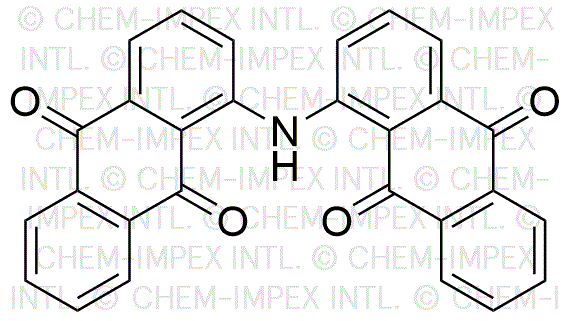1,1'-Iminodianthraquinone is widely utilized in research focused on:
- Dyes and Pigments: This compound is used in the production of high-performance dyes, particularly in textiles and coatings, due to its vibrant color and stability.
- Photovoltaic Cells: It serves as a key material in organic solar cells, enhancing their efficiency by improving light absorption and charge transport.
- Organic Electronics: The compound is integral in the development of organic semiconductors, which are crucial for flexible electronic devices and displays.
- Antioxidant Applications: Its antioxidant properties make it valuable in formulating products that require protection against oxidative stress, such as in cosmetics and food preservation.
- Research in Photochemistry: It is extensively studied for its photochemical properties, aiding in the development of new materials for light-driven applications, including sensors and catalysts.
Informations générales
Propriétés
Sécurité et réglementation
Applications
1,1'-Iminodianthraquinone is widely utilized in research focused on:
- Dyes and Pigments: This compound is used in the production of high-performance dyes, particularly in textiles and coatings, due to its vibrant color and stability.
- Photovoltaic Cells: It serves as a key material in organic solar cells, enhancing their efficiency by improving light absorption and charge transport.
- Organic Electronics: The compound is integral in the development of organic semiconductors, which are crucial for flexible electronic devices and displays.
- Antioxidant Applications: Its antioxidant properties make it valuable in formulating products that require protection against oxidative stress, such as in cosmetics and food preservation.
- Research in Photochemistry: It is extensively studied for its photochemical properties, aiding in the development of new materials for light-driven applications, including sensors and catalysts.
Documents
Fiches de données de sécurité (FDS)
La FDS fournit des informations de sécurité complètes sur la manipulation, le stockage et l’élimination du produit.
Spécifications du produit (PS)
Le PS fournit une description complète des propriétés du produit, notamment sa composition chimique, son état physique, sa pureté et les exigences de stockage. Il détaille également les plages de qualité acceptables et les applications prévues du produit.
Certificats d'analyse (COA)
Recherchez des certificats d'analyse (COA) en saisissant le numéro de lot du produit. Les numéros de lot et de lot se trouvent sur l'étiquette d'un produit, après les mots « Lot » ou « Lot de fabrication ».
Numéro de catalogue
Numéro de lot/série
Certificats d'origine (COO)
Ce certificat d'exploitation confirme le pays dans lequel le produit a été fabriqué, et détaille également les matériaux et composants utilisés et s'il est issu de sources naturelles, synthétiques ou autres sources spécifiques. Ce certificat peut être requis pour les douanes, le commerce et la conformité réglementaire.
Numéro de catalogue
Numéro de lot/série
Fiches de données de sécurité (FDS)
La FDS fournit des informations de sécurité complètes sur la manipulation, le stockage et l’élimination du produit.
DownloadSpécifications du produit (PS)
Le PS fournit une description complète des propriétés du produit, notamment sa composition chimique, son état physique, sa pureté et les exigences de stockage. Il détaille également les plages de qualité acceptables et les applications prévues du produit.
DownloadCertificats d'analyse (COA)
Recherchez des certificats d'analyse (COA) en saisissant le numéro de lot du produit. Les numéros de lot et de lot se trouvent sur l'étiquette d'un produit, après les mots « Lot » ou « Lot de fabrication ».
Numéro de catalogue
Numéro de lot/série
Certificats d'origine (COO)
Ce certificat d'exploitation confirme le pays dans lequel le produit a été fabriqué, et détaille également les matériaux et composants utilisés et s'il est issu de sources naturelles, synthétiques ou autres sources spécifiques. Ce certificat peut être requis pour les douanes, le commerce et la conformité réglementaire.


